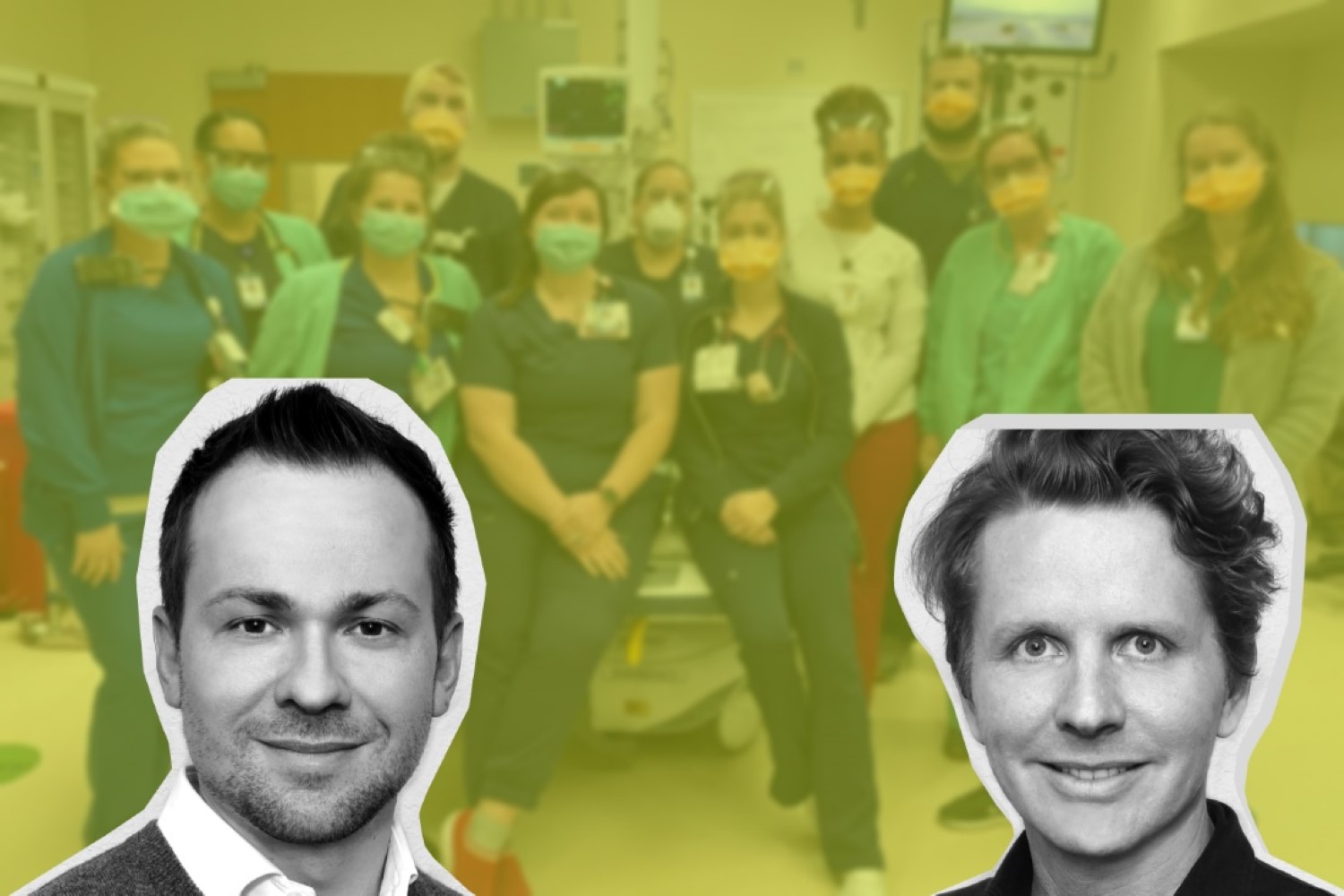Caresyntax to Debunk Its Impactful Trajectory to Make Surgery Smarter and Safer
Each year, millions of lives are saved and improved in operating rooms. But it is also a place where nightmares occur.
“For the past few years, analytics have consumed nearly every aspect of our lives, from businesses to social media to sports — but the operating room remained one of the lone places with troves of data yet to be uncovered,” said Dennis Kogan, Caresyntax founder and CEO.
That leads to the establishment of Caresyntax in 2016. Björn von Siemens and Dennis Kogan founded the company with the goal of improving surgery’s efficiency, safety, and financial viability. The team offers software, data, and professional services solutions across the entire surgical continuum.
Caresyntax’s digital surgery platform uses proprietary software and artificial intelligence to evaluate large volumes of real-world data in and around the operating room (OR) in order to deliver insights that can be used immediately by the medical team and longer-term by a variety of critical stakeholders, including surgeons, to assess and improve care.
Caresyntax also provides virtual, real-time access to outside professionals through its platform, including medical device reps and instructors from medical schools.
The end goal of Caresyntax is to improve patient safety and surgical efficiency. By analyzing massive amounts of video, audio, picture, device, clinical, and operational data in and around the OR with proprietary software and artificial intelligence (AI), their enterprise-grade data-driven surgical platform provides actionable insights to enhance patient outcomes.
Through the platform’s dedicated telehealth link, this real-world evidence may be accessible by anyone outside the operating room as well as used live by the care team during a procedure.
After an operation, the Caresyntax platform offers data that assist surgeons in benchmarking and improving their care, hospital managers in making better use of surgical resources, medical device firms in developing better products, and insurance companies in understanding risk and creating more specialized policies.
Headquartered in Boston, Caresyntax software is used in more than 4,000 operating rooms worldwide and supports surgical teams in over two million procedures per year.
“Our platform created a new space in the market at the intersection of data collection and analysis that allows hospitals, medtechs, insurers and others to operate more efficiently and improve patient outcomes.” said Dennis Kogan, Caresyntax founder and CEO.
Rising from Fulfilling the Need of a “Digital Safety Net” for Surgery
According to statistics, the operating room is one of the riskiest places on earth: of the 313 million surgical operations that take place worldwide each year, complications occur in 5.3% of the cases and postoperative deaths account for 7.7% of all global deaths.

These mistakes damage the patient-surgeon relationship and place a psychological load and stress on surgical teams. For hospitals, they result in expensive reoperations and litigations that may last months or even years.
The reasons for these errors will be transparent when looking at the structural, organizational, and technological stressors that surgeons face. Surgeons operate in highly stressful environments where patient lives are at stake, technology is always evolving, and team members can disappear or change.
Up to 9.9 million medical workers could be missing until 2030, even though, in the European region for example, the number of medical staff has increased by approximately 10% over the past 10 years.
Consequently, surgeons have less time for each patient to spare while the patient backlog is growing. Additionally, there are a lot of data sources that account for increasingly complex situations and therapies.
The COVID-19 pandemic has made these problems worse by adding workloads and volatility: in April 2020, surgery volumes in the US were cut by 59%, and resident training in the US was interrupted by the crisis to the tune of 80%.
As a result of severe staff shortage, some US states declared an emergency in September 2021 and hospitals had to start turning away patients. Despite this, there is still little automation or support; many processes and systems have basically remained the same for years.
Because of this, Caresyntax showed up and helped bring digital tools into the operating room. New applications are changing the way surgical workflows are performed, analyzed, and learned from: a digital safety net for surgery.
Caresyntax is creating just such a safety net by assisting surgeons and their teams during procedures and gathers novel data that is available for review and development of applications.
This means that risks can be avoided before they arise thanks to guidance from one surgical step to the next, automated warning systems that halt frequent errors in some operations, and post-surgery video-based assessments (VBA) that encourage greater awareness and foster learning.
By creating an environment that provides healthcare professionals with guidance and VBA awareness instruments, many advantages come to help develop and optimize procedures to keep patients and surgeons safe

Surgeons are guided in critical situations and can easily identify and correct errors to specific actions. As a result, surgeon skills are greatly improved.
Additionally, patients experience much less X-RAY time due to quicker and more effective operations, and they are also at a lower chance of developing potentially fatal surgical side infections (SSI).
Caresyntax has seen measurably better patient outcomes, better clinical team skills, and more successful surgeries across the more than 4,000 operating rooms worldwide that employ digital surgery solutions, including those at UC San Diego, Sheba Medical Israel, University Hospital of Strasbourg, and Charité Universitätsmedizin Berlin, to name a few.
There were lower complication rates, operating times as well as readmission rates among patients that have been treated with Caresyntax or equivalent digital platforms inside the operating room and lesser visits to the emergency department have been recorded.
Also, Caresyntax’s customers work more efficiently in uncertain environments: Performing on average 1.5 more surgeries per day during COVID-19, where CX also retained 16% more surgical caseload for customer clinics.
How Caresyntax Technology Works and Its Early Business Achievements
Healthtech startup Caresyntax’s digital surgical platform places a strong emphasis on data. The startup’s ability to provide a wide range of products, including automation and AI in the operating room, video and data-based surgical pathways, telepresence in surgery, and their own CX-PSO (Caresyntax patient safety organization), a neighborhood-wide data sharing network, is made possible by integrating data into the platform.
Caresyntax offers important insight that can assist enhance surgical treatment at every stage by evaluating vast amounts of real-world data. Additionally, the platform of the healthtech company offers virtual, real-time access to medical professionals of all stripes, including medical school professors and representatives of medical devices. By boosting productivity and lowering the chance of errors, the digital platform can also assist hospitals in lowering their overall surgery expenses.
The healthtech business has generated a lot of success early on already. In fact, the company has seen 250% growth in the 2020.

As part of the 5th Annual MedTech Breakthrough Awards in 2021, the company took up the “Healthcare Analytics Innovation Award.” Out of almost 4,000 candidates, Caresyntax was chosen, joining winners like Zimmer Biomet and Boston Scientific.
In September 2022, Caresyntax revealed that it has joined the World Economic Forum’s (WEF) Global Innovators Community, as part of the WEF Unicorn track.
Dennis Kogan, the founder and CEO of Caresyntax, commented on the efficiency of the system, “Operating rooms need to perform as effectively and efficiently as possible, and this is especially true now to make up for the surgical backlog driven by the pandemic. With better technology to safely automate surgical pathways while generating decision-grade real-world evidence, we will improve health care decision-making, mitigate surgical risks, and advance high-value medical technology.”
Raising $130 Million for Its Timely Innovative Platform
In April 2021, Caresyntax declared that it had closed a $100 million Series C funding round led by PFM Health Sciences LP, and included involvement from Optum Ventures, Intel Capital, Lauxera Capital Partners, Vesalius Biocapital III, Arno Capital, Rezayat Investments, as well as current investors IPF Partners, the Relyens Group, and Surgical.AI.
Later, in September 2021, $30 million additional was added to the funding. The additional investment brings the total Series C funding to $130 million, building on the first stage that was announced in 2021.
The funding will help Caresyntax speed up expansion in key markets, further research and development of its AI analytics, build out its platforms, and enlarge its employee base.
“Caresyntax is helping bend the curve towards better patient outcomes and more efficient workflow through extracting unique insights from structured and unstructured data in surgery,” said Dr. Anant Ahuja, Partner at PFM Health Sciences.
Dr. Anant added, “We are highly confident their technology platform will reduce clinical and business risks for all stakeholders in surgery, as it grows into a first-of-its-kind enterprise solution for data analytics in the operating room.”
Caresyntax’s growth occurs at a critical moment for hospitals as canceled surgical operations contributed to more than $200 billion in revenue losses between March and June of 2020. To compound those losses, it is estimated that it could take up to two years to work through the surgical logjam, even operating at 10-20% above historical volume.
“Amid all of the burdens brought on by COVID-19, hospital leaders globally will need to rely even more on analytics technology to drive value and positive outcomes in the OR,” said Dr. Vijay Barathan, Optum Ventures. “The Caresyntax digital surgery platform has the intelligence and the breadth to meet this challenge.”
Expanding Its Size by Acquisition and Partnerships
At the close of 2019, Caresyntax announced the acquisition of Syus, a leader in operating room operations and cost analytics. This acquisition increased Caresyntax’s hospital footprint and strengthened its ability to use real-world data to improve hospital business performance.
Since the acquisition, Caresyntax has collaborated with prestigious organizations to enhance virtual training and identify safety indicators for clinical settings, including University of Iowa Health Care to evaluate and standardize pathways in the OR and the University of Massachusetts Medical School to modernize virtual training and identify safety indicators.
In 2020, CareSyntax officially confirmed the launch of a new collaboration with Diversified, an industry leading technology solutions integrator. The partnership will help Caresyntax to accelerate the development and deployment of an even broader range of operating risk management and outcome improvement solutions in health systems across North America.

The collaboration highlights caresyntax’s establishment of an ecosystem for digital surgery that is completely integrated, multipurpose, and connects technology vendors delivering data-driven solutions to healthcare systems, medical device makers, and insurance companies.
In April 2021, Caresyntax was picked by the American Board of Surgery to provide a platform for its pilot program integrating video-based evaluations into their board certification process.
“We’ve witnessed rapid evolution in the devices that are used to perform surgery itself, but less progress in the tools that help the caregivers handle the increasing complexity and volume of surgical procedures,” said Stacey Shulman at Intel Capital.
Stacey Shulman added, “If we’re going to see real improvement in surgical outcomes, we must first help everyone in and around the operating room clear the surgical backlog post-COVID, while collecting the unique clinical insights that can power more reliable decision support systems for the long term. Caresyntax can provide the granular workflow access and the surgical data needed to accomplish those goals.”
In July 2022, Caresyntax revealed an ongoing collaboration with Intel. The two businesses will combine their resources to create ground-breaking new surgical technologies that will advance Caresyntax’s data-driven surgery platform and solve major surgical issues.
The collaboration is another pivotal step after Intel Capital became an investor in Caresyntax’s Series C funding round in 2021. As part of the partnership, Caresyntax will use Intel’s experience in AI applications to create solutions that address the acute surgery staffing shortage.
The Caresyntax Personalized Surgical Playbook and turn-by-turn guidance functionality for surgical staff, powered by Intel technologies, allow quick onboarding of new clinicians and travel nurses. Turn-by-turn instructions are given to the surgical team in the operating room to support the surgeon at each stage of the procedure.
Not Just in the Local, Caresyntax Grows Beyond the States
The company’s growth in the United States has been accompanied by successes abroad. One of the biggest medical malpractice reinsurers in Europe, Relyens, uses Caresyntax’s platform for video and other real-world data-based assessments connected to patient outcomes to assist manage surgical risk.
Caresyntax software programs have been utilized by the University Hospital of Strasbourg to record orthopedic training, which has enhanced risk management, learning curve optimization, and test results. Additionally, the largest medical facility in the Middle East, Sheba Medical Center, has a research collaboration with Caresyntax that analyzes oncological surgical data across more than 300 variables to create algorithms that can predict surgery outcomes and improve patient care.









